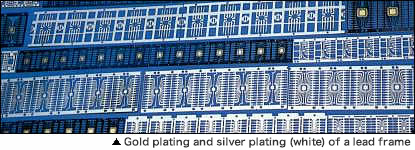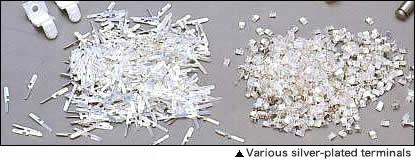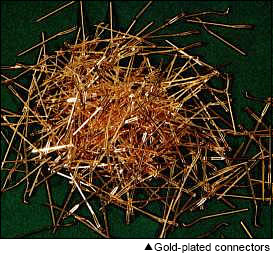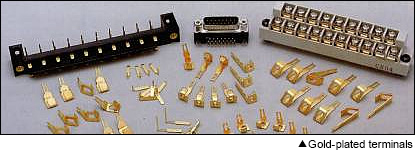(1)Rhodium plating Rh
Industrial rhodium plating has a high hardness of 800 to 1000 Hv, comparable to that of industrial chrome plating. It also has superior corrosion resistance. Therefore, it is used for those parts that are subject to intense abrasion and sliding and that require a long-term stable low contact resistance, such as for terminal plating of printed circuit boards, connectors, and switch contacts.
The following are the characteristics of rhodium plating:
| | 1. | It is chemically stable and is not susceptible to oxidative discoloration at normal temperature. |
| | 2. | It has extremely high hardness and excellent wear resistance. |
| | 3. | It has superior heat resistance and does not oxidize in the air at 500℃ or lower. |
| | 4. | It has electrical resistance of 490 uΩ/m, which is twice that of gold but is the lowest among the platinum group. |
| | 5. | It is used for discoloration prevention of ornaments and silverware for its delicate silver gray luster with a high reflectivity of 80%. |
| | 6. | Contact-related plating thickness can be roughly categorized as follows:
・For discoloration prevention: 0.5 um or less
・For wear resistance: 0.5 to 2.0 um
・For high wear resistance: 2.5 to 25 um |
(2)Platinum plating Pt
Platinum is more commonly known than rhodium but is less commonly used for plating.Although hardness of platinum plating is lower than that of rhodium plating, platinum plating containing 5 to 10% rhodium is said to have high hardness.It is used for contacts of electronic equipment, as in the case of rhodium plating, due to its excellent resistance to oxidation, corrosion, and heat.
For salt electrolysis, platinum-plated titanium is used as an insoluble anode.It has outstanding corrosion resistance.
(3)Palladium plating Pd
Compared to rhodium plating, palladium plating is less expensive but has inferior wear resistance and corrosion resistance.Its shortcomings include formation of polymer by binding to organic matters in the air when used as an electrical contact.Nonetheless, it is used as a low contact resistance plating to substitute for expensive rhodium plating.
(4)Ruthenium plating Ru
Ruthenium plating has similar low contact resistance, hardness, wear resistance, and corrosion resistance to rhodium plating but is 1/2 as expensive. Therefore, it is a promising substitute for rhodium plating with a well-anticipated future development to address the difficulty in plating a thick coat of 3 um or more without forming cracks caused by internal stress.






